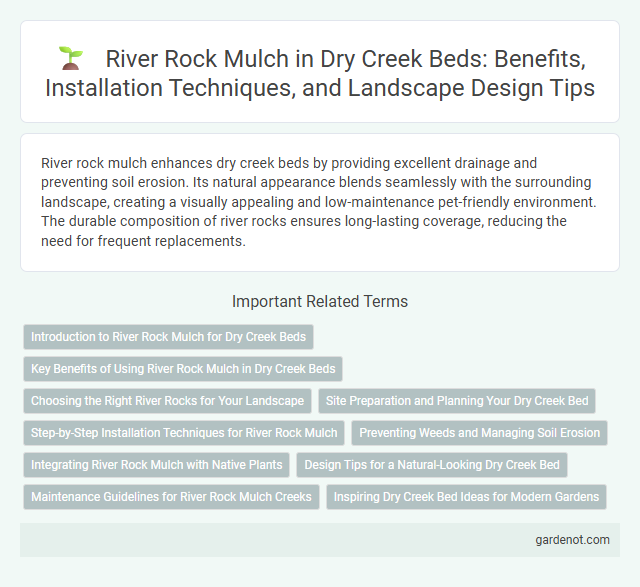River rock mulch enhances dry creek beds by providing excellent drainage and preventing soil erosion. Its natural appearance blends seamlessly with the surrounding landscape, creating a visually appealing and low-maintenance pet-friendly environment. The durable composition of river rocks ensures long-lasting coverage, reducing the need for frequent replacements.
Introduction to River Rock Mulch for Dry Creek Beds
River rock mulch enhances dry creek beds by providing excellent drainage and reducing soil erosion while maintaining a natural, aesthetically pleasing appearance. Its durable composition and smooth texture help suppress weed growth and retain moisture in surrounding plants, making it an ideal choice for arid landscaping. Using river rock mulch in dry creek beds supports sustainable water management and complements xeriscape gardening designs effectively.
Key Benefits of Using River Rock Mulch in Dry Creek Beds
River rock mulch enhances dry creek beds by improving drainage and preventing soil erosion, ensuring long-lasting landscape stability. Its natural appearance blends seamlessly with the environment, reducing weed growth and minimizing maintenance needs. The durable, weather-resistant properties of river rock mulch also help regulate soil temperature and moisture, promoting healthier plant roots.
Choosing the Right River Rocks for Your Landscape
Selecting the right river rocks for your dry creek bed enhances both functionality and aesthetic appeal, with sizes typically ranging from 1 to 4 inches to ensure proper water drainage and erosion control. Natural smooth stones with varied colors and textures create a visually appealing contrast while blending seamlessly into outdoor environments. Prioritizing durable, weather-resistant rocks like granite or quartz ensures long-lasting performance under varying weather conditions.
Site Preparation and Planning Your Dry Creek Bed
Before installing river rock mulch in a dry creek bed, thoroughly assess the area for proper drainage and slope to prevent water pooling. Remove any existing vegetation and level the soil, incorporating a weed barrier fabric to inhibit weed growth while allowing water permeation. Planning the layout with varying rock sizes enhances natural aesthetics and ensures the durability of the dry creek bed during seasonal changes.
Step-by-Step Installation Techniques for River Rock Mulch
Begin the installation of river rock mulch in a dry creek bed by first clearing debris and leveling the area to ensure proper drainage and stability. Lay down a high-quality landscape fabric to prevent weed growth while allowing water permeability, then evenly spread a 2-3 inch layer of river rock mulch for effective erosion control and aesthetic appeal. Compact the rocks gently with a hand tamper to secure the mulch in place and maintain its natural appearance while facilitating water flow through the creek bed.
Preventing Weeds and Managing Soil Erosion
River rock mulch effectively prevents weeds by creating a dense barrier that blocks sunlight, inhibiting weed seed germination. Its heavy, coarse texture stabilizes dry creek beds, reducing soil erosion during heavy rainfall and water runoff. Using river rock mulch also improves soil moisture retention while maintaining proper drainage, supporting healthy plant growth.
Integrating River Rock Mulch with Native Plants
River rock mulch enhances dry creek beds by improving soil moisture retention and reducing erosion, creating a naturalistic landscape aesthetic. Integrating native plants with river rock mulch supports local biodiversity, promotes drought resistance, and requires minimal maintenance. This combination stabilizes the ecosystem while providing a harmonious visual appeal that mimics natural creek environments.
Design Tips for a Natural-Looking Dry Creek Bed
Use varied sizes and colors of river rock mulch to mimic the randomness found in natural creek beds, enhancing visual authenticity. Incorporate native plants with deep root systems along the edges to stabilize soil and create a seamless transition between rock and landscape. Layer smaller pebbles around larger stones to add texture and improve drainage, maintaining a natural water flow appearance.
Maintenance Guidelines for River Rock Mulch Creeks
River rock mulch in dry creek beds requires occasional removal of debris and fallen leaves to maintain proper drainage and aesthetic appeal. Periodic rinsing with water helps prevent the accumulation of dirt and algae, ensuring the rocks retain their natural color and texture. Inspecting for displacement after heavy rainstorms and repositioning rocks as needed preserves the integrity of the creek bed design and prevents erosion.
Inspiring Dry Creek Bed Ideas for Modern Gardens
River rock mulch enhances dry creek beds by providing natural drainage while adding a sleek, contemporary aesthetic to modern gardens. Its smooth, rounded stones create visual contrast and texture, promoting water flow and preventing soil erosion effectively. Integrating varied sizes and complementary plants within the river rock mulch elevates the overall landscape design, inspiring unique and maintenance-friendly outdoor spaces.
River rock mulch Infographic

 gardenot.com
gardenot.com